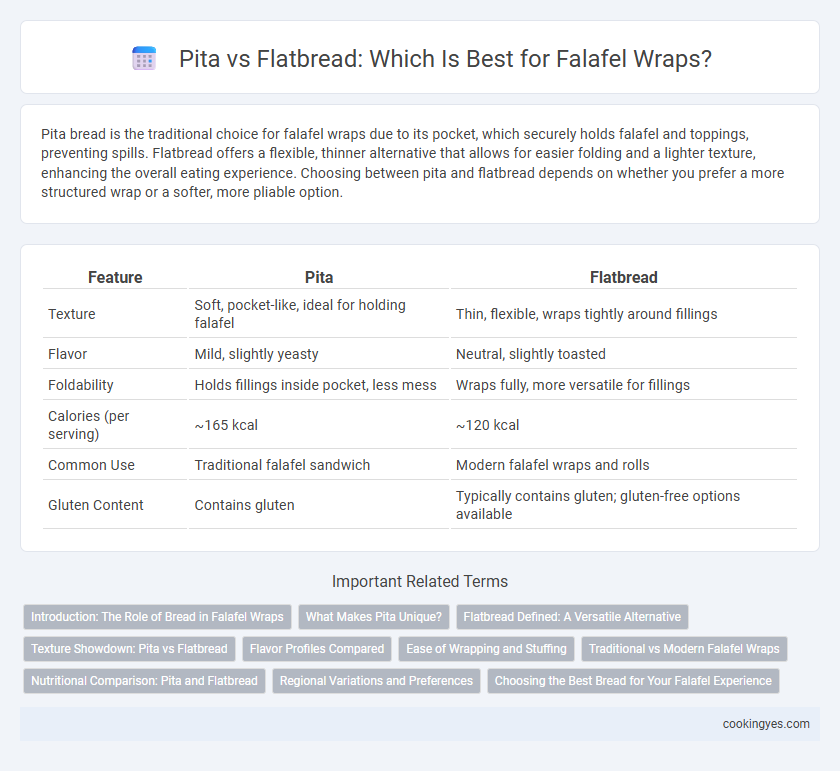Pita bread is the traditional choice for falafel wraps due to its pocket, which securely holds falafel and toppings, preventing spills. Flatbread offers a flexible, thinner alternative that allows for easier folding and a lighter texture, enhancing the overall eating experience. Choosing between pita and flatbread depends on whether you prefer a more structured wrap or a softer, more pliable option.
Table of Comparison
| Feature | Pita | Flatbread |
|---|---|---|
| Texture | Soft, pocket-like, ideal for holding falafel | Thin, flexible, wraps tightly around fillings |
| Flavor | Mild, slightly yeasty | Neutral, slightly toasted |
| Foldability | Holds fillings inside pocket, less mess | Wraps fully, more versatile for fillings |
| Calories (per serving) | ~165 kcal | ~120 kcal |
| Common Use | Traditional falafel sandwich | Modern falafel wraps and rolls |
| Gluten Content | Contains gluten | Typically contains gluten; gluten-free options available |
Introduction: The Role of Bread in Falafel Wraps
Pita bread's pocket structure creates an ideal vessel for falafel, effortlessly containing fillings like tahini, vegetables, and pickles without spillage. Flatbread offers a versatile, thin alternative that allows for more customizable wrap sizes and a lighter texture. Choosing between pita and flatbread influences the overall eating experience and texture balance in a falafel wrap.
What Makes Pita Unique?
Pita bread stands out in falafel wraps due to its distinctive pocket, created by steam during baking, which perfectly holds falafel and toppings without spilling. Its soft yet slightly chewy texture balances the crunch of fried falafel, enhancing the overall eating experience. Unlike flatbread, pita's ability to encase fillings makes it the optimal vessel for traditional falafel wraps.
Flatbread Defined: A Versatile Alternative
Flatbread serves as a versatile alternative to pita for falafel wraps, offering a thinner, more flexible texture that easily folds without tearing. Unlike pita, which features a pocket for holding fillings, flatbread provides an open surface that allows for a customizable distribution of falafel, vegetables, and sauces. This adaptability makes flatbread ideal for diverse flavor combinations and contemporary wrap styles while maintaining the authentic taste of Middle Eastern cuisine.
Texture Showdown: Pita vs Flatbread
Pita offers a soft, pillowy texture with a pocket that holds falafel and fillings securely, enhancing the overall eating experience. Flatbread provides a chewier, more flexible base that allows for easier folding and a crispier bite when toasted. Choosing between pita and flatbread for a falafel wrap depends on whether you prefer a light, airy feel or a hearty, textured chew.
Flavor Profiles Compared
Pita bread offers a soft, slightly chewy texture with a mild, yeasty flavor that complements the savory and herbaceous notes of falafel without overpowering them. Flatbread, often thinner and with a more neutral taste, allows the robust spices and crispy exterior of falafel to stand out more prominently in each bite. Choosing between pita and flatbread depends on whether you prefer a bread that adds a subtle taste dimension or one that acts as a simple vessel to showcase falafel's complex flavors.
Ease of Wrapping and Stuffing
Pita bread features a pocket that simplifies stuffing falafel, making it easier to secure fillings without spillage. Flatbread offers greater flexibility for wrapping but requires more skill to fold without tearing, especially when filled with multiple ingredients. For ease of wrapping and stuffing, pita's structured pocket provides a convenient and mess-free option for falafel wraps.
Traditional vs Modern Falafel Wraps
Pita bread is the traditional choice for falafel wraps, featuring a pocket ideal for holding falafel balls, tahini, and fresh vegetables, preserving the classic Middle Eastern flavor profile. Modern falafel wraps often use various types of flatbreads, such as laffa or tortilla, which offer a larger surface area and a softer texture, catering to contemporary preferences for diverse flavors and fillings. The distinction between pita and flatbread reflects the evolution from authentic recipes to innovative culinary adaptations in falafel preparation.
Nutritional Comparison: Pita and Flatbread
Pita and flatbread both serve as popular bases for falafel wraps, with pita typically offering around 165 calories, 1.5 grams of fat, and 33 grams of carbohydrates per 60-gram serving, while flatbread contains approximately 200 calories, 3 grams of fat, and 36 grams of carbohydrates per similar serving size. Pita usually provides higher fiber content, averaging 3 grams versus flatbread's 1-2 grams, contributing to better digestive benefits and prolonged satiety. Protein levels are comparable, but pita's lower fat and calorie count make it a more favorable choice for those aiming to reduce calorie intake without sacrificing taste in falafel consumption.
Regional Variations and Preferences
Pita and flatbread serve as the primary bases for falafel wraps with notable regional variations shaping preferences. In the Middle East, especially in countries like Israel, Lebanon, and Palestine, pita bread is favored for its pocket-like structure that neatly holds falafel and toppings, enhancing convenience and texture. Conversely, in North African regions such as Egypt and Morocco, flatbreads like laffa are preferred due to their larger, softer, and more pliable nature, accommodating generous falafel fillings and an array of traditional sauces.
Choosing the Best Bread for Your Falafel Experience
Pita bread offers a pocket that securely holds falafel, making it ideal for a convenient, handheld wrap filled with fresh vegetables and tahini sauce. Flatbread provides a flexible, thinner option that allows for more even distribution of falafel and toppings, enhancing the balance of flavors in every bite. Choosing between pita and flatbread depends on whether you prefer structural support or a lighter, customizable wrap experience for your falafel.
Pita vs Flatbread for Falafel Wrap Infographic

 cookingyes.com
cookingyes.com